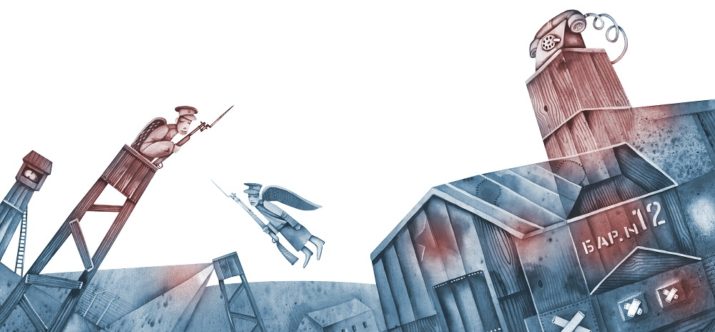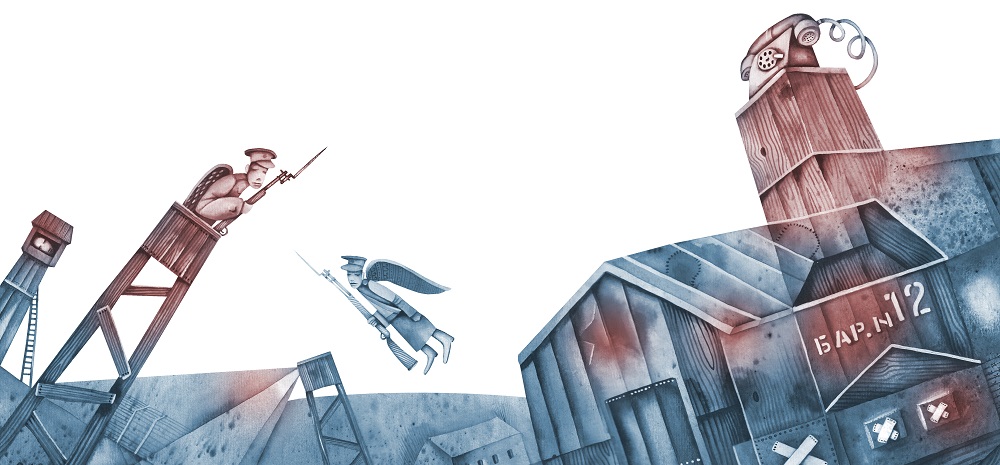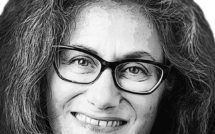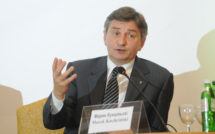

This is part of our feature on Poets and Power: Language of Resilience from Central and Eastern Europe
Тоска по родине!…
Мне совершенно все равно,
Где – совершенно одинокой
Быть…
(This thing called homesickness!…
Because for me it does not matter
Where to be completely so
Alone…)
—MarinaTsvetaeva[1]
“Una pasión rusa —A Russian Passion”
One of the on-going features of modern-day Spain is the “rediscovery” of Russia and her culture and history after so many years of enforced silence between the two countries during the Franco regime. For example, the Year of Spanish-Russian Culture in 2012 witnessed, among other things, a heightened presence of Russian theatrical productions throughout Spain and a special interest in new and complete translations of the writings of authors such as Chekhov.[2] Madrid now has its own splendid Russian Orthodox Church situated in Gran Vía de Hortaleza which, in many ways, has become a focus of Russianness at the very heart of Spain’s capital, dealing not only with religious matters but attempting to be open and inclusive of the Spanish community too. Two years ago a prize-winning “historical novel” by journalist Reyes Monforte, “Una pasión rusa” (“A Russian Passion”), made its own very special impact among the Spanish reading public. The novel, in a creative and a poetic way, attempted to reconstruct the life of Carolina Codina (1897-1989), the “official” widow of the composer Sergei Prokofiev.[3] Moving from this somewhat fictionalized account of Codina’s life, an investigation of some of the real facts of Codina’s existence astonishingly and unexpectedly reveals a most extraordinary life which in so many ways was stranger than fiction and one which crossed over and engaged with a vast number of cultures, languages, countries, political regimes and experiences. It was a life which moved sharply and abruptly from the elegant salons of Coco Chanel in Paris, and from meetings with eminent European literary and musical figures to eight years of hard labor in the Soviet Gulag. It would seem from the evidence available that Codina had been both denounced and rejected by Prokofiev who had formed a relationship with Mira Mendelson and had subsequently abandoned Codina and their two sons at the outset of the Second World War. Codina lived through (and in some cases had direct experience of) a number of the greatest upheavals of the 20th century – from the Bolshevik Revolution in 1917, through the The Spanish Civil War, and then the worst years of Stalin’s purges in the USSR, which indeed made a direct impact on her life. Her lawyer André Schmidt who knew her in the last years of her life observed as follows:
She was a great lady, a truly great lady but she is unknown. She was an exceptional personality. I am only sorry that she did not quite live to see the liberation of Russia and the fall of the Berlin Wall.[4]
From my research that has been carried out thus far it is clear that, in addition, Codina’s life conceals many other fascinating and to this day unresolved issues in the whole intricate web of Hispano-Russian relations; for example while a prisoner in the Gulag, she met and even sang with a fellow Spaniard who belonged to the so-called “Niños de Rusia” (“The Children of Russia”), an issue which is still frequently discussed in Spain today and which has been the subject of films, exhibitions and documentaries since approximately 2004.[5] The wider aim of this current project is to try to investigate further and to expand on the small fragments of fact which exist around the Codina-Prokofiev relationship and, indeed, around the details of Codina’s own life in order ultimately to offer a much fuller version of “her story.” Codina will additionally serve as the central focus around which four works of fiction, all authored by women, two Soviet and two Spanish, will be analyzed and the “real” and the “fictional” will be compared and contrasted. All four novels were written around the time of the breakdown of Codina’s family life, her arrest and her time as a prisoner in the Gulag and these works all reflect certain aspects of the reality of those times.
Codina’s own highly unusual life, which encompassed, on the one hand, the utmost heights of poetic and musical experience and beauty was also tragically marked by the depths of betrayal and all imaginable horrors of cruelty and human suffering. This piece has as its aim to provide a few initial remarks that relate to stages in this longer research process and it makes some use of materials which to date have not been available in English.
While Russian commentators on Codina’s life have tended to err on the cautious side, as a rule, it may come as no surprise to discover that today’s Spanish perceptions of her are often presented under somewhat emotionally charged titles “Una española en el Gulag” (“A Spanish Woman in the Gulag”), for example, and her bravery, loyalty and moral fortitude together with her indomitable spirit and rectitude have been described as “las cualidades de una verdadera española” (“the qualities of a true Spanish woman”).[6] The four writers who have been chosen to “illuminate” aspects of Codina’s life through their fiction were too all “extraordinary” and each one managed in her own way to circumvent the censorship rules in place under, on the one hand, Franco’s Spain and the dictates of Socialist Realism on the other and give “authentic” fictional accounts of the lives of women, which included dealing with issues such as adultery, betrayal, prison, domestic violence, divorce. All four writers were literary prizewinners in Spain and the USSR respectively and while Carmen Martín Gaite (1925-2000) and Mercè Rodoreda (1908-1983) are well-known and widely researched in academia today the two Soviet authoresses, Galina Nikolaeva (1911-1963) and Antonina Koptiaeva (1909-1991?), have been largely forgotten. The four novels that have been chosen for this project are Martín Gaite’s “Entre visillos” (“Behind the Curtains”), 1957, which offers a vision of the entrapment and restrictions of women’s lives in the Franco era; Rodoreda’s “La plaça del Diamant” (“Diamond Square”), 1962, which focuses, among other things, on the impact of war, suffering, starvation and domestic abuse on the life of the female protagonista; Nikolaeva’s so-called “factory novel” “Битва в пути” (“The Struggle along the Way”) in reality conceals a “novel within a novel,” namely the story of the life of the female protagonist, Tina, as she struggles to make sense of a life marked out by loneliness, adultery, loss and betrayal. The last novel is the remarkable work by Koptiaeva written in 1946, “Товарищ Анна” (“Comrade Anna”) which “reverses,” so to speak the main plot of Tolstoy’s great novel of adultery and examines the impact of rejection and the destruction of her family on Anna, the heroine of the work. Codina’s accounts of her own life will be, as noted, compared and contrasted with aspects of the fictionalized accounts of “her story” noted above and appropriate conclusions drawn.
1897 – 1948 – 1989 From Madrid to Abez…and Back Again
Carolina Codina was born in a house in one of Madrid’s most elegant streets, Bárbara de Braganza, no. 4, in 1897. Many scholars of Spanish culture take the view that just one year later, 1898, Spain was to enter into a new era marking a transition into a very different world with the loss of all her remaining colonies. The so-called “1898 Generation”of writers, scholars and thinkers in an attempt to “solve” Spain’s problems looked, in many cases, to Russia for inspiration.[7] Today there exists a small plaque to the memory of Carolina Codina just above the flat where she lived as a child; the wording on the plaque is significant in that she is remembered not in her own right, so to speak, but as “la viuda del compositor ruso Prokofiev” (“the widow of the Russian composer Prokofiev”). On numerous occasions I have asked passers-by if they knew who Carolina Codina was and not a single person had heard of her…most knew of Prokofiev, as might be expected; a few had read the book by Monforte mentioned above and then they made the connection. Some people even jokingly suggested that the severe winters of Madrid may have prepared Codina well for the rigors of the climate in the extreme north of the USSR during her years in the Gulag.
Codina’s mother, Olga Nemiskaia, had been born into an aristocratic family in Warsaw but she was educated in St Petersburg; Russian, Spanish and English were the “family” languages. Her father, Juan Codina, was of Catalan/Spanish origin and both parents were involved in the world of music – mostly as opera singers, and the family travelled widely both in Europe and in America. Codina had a traditional upbringing for the era, her mother holding strict views about marriage – “Una mujer debe cuidar del hombre y ofrecerle su virginidad” (“A woman must look after a man and offer him her virginity”).[8] However at the insistence of both parents Codina had a proper education – which was significant considering the difficulties of the constant movements and changes of location to which she was subjected while growing up, not to mention the somewhat precarious financial situation of her family. She spoke six languages fluently, Spanish, Russian, English, French, German and Catalan and could manage fairly well in Italian and Polish. As she herself relates, Codina met Prokofiev in the United States in 1919 and they were married in Germany in 1923. Their two sons, Sviatoslav and Oleg, were born in 1924 and in 1928 respectively. She notes:
I was a singer and I studied in Italy; I performed in opera and also in my husband’s concerts in the United States and in many European countries. When Sergei Sergeivich decided to return to his homeland I fully supported his decision. In 1936 our entire family moved to the USSR and I received Soviet citizenship. The Soviet Union became my second homeland…[9]
It is well known that Codina collaborated with and assisted Prokofiev in a number of his early works and that in the first years of their marriage he encouraged her singing career and supported her desires to perform on stage. Codina not only shared in Prokofiev’s musical work but she also cared for his ailing mother with great devotion. One is too struck by the affection and the desire to share every detail of his life which are apparent in many of the composer’s letters to her, even after the latter’s adulterous relationship with Mira Mendelson had commenced.[10] By 1948 Prokofiev had already abandoned his two sons and wife and was living with Mira Mendelson, a much younger student of poetry – they had met at a spa – and Mendelson from the outset, it appears, had been determined to “catch” the composer and destroy his marriage and family.[11] In February 1948 Codina was arrested on charges of espionage and after a very long period of interrogation and torture in Moscow she was sentenced to 20 years hard labour in one of the worst Gulags in the former USSR, Abez.[12] After Stalin’s death in 1953 (Prokofiev and Stalin both died on the same day) Codina’s sentence was reduced and she was moved to a camp at Potma; she was finally released on June 30th 1956. While on the one hand being unwilling to talk about her Gulag years, after her release Codina fought to be recognised as the “official” widow of Prokofiev and to be allowed to leave the USSR. She was successful on both accounts and in 1974 she left Russia forever, permission having been granted to her by Andropov.[13] In that same year she received a Spanish passport and from 1974 until her death in London in 1989 she traveled widely in both Europe and America and had as her main aim in life to promote both the music and the memory of her husband. She returned to Madrid on several occasions.
The Enigma
As we have noted above, there are very many features of Codina’s life which remain both unexplained and poorly researched. She was reluctant, as noted, to speak about her experiences in the Gulag so most of the information which exists about her time there comes from reports given by those who knew her while she was in detention and in particular from conversations with family members, especially her grandsons.[14] As is known, both Codina and Prokofiev were Christian Scientists and the impact of this religion on their lives requires much fuller investigation.[15]
Codina also met and made friendships with eminent literary figures of the time including, for example, the Soviet writer Yurii Olesha, whom she seems to have known well and she also made the acquaintance of Lorca while in Cuba and had admired his work greatly.[16] Because of her excellent command of many languages Codina was able to cross many boundaries both cultural and national; in fact her superb knowledge of German may almost paradoxically have saved her life while she was in Abez; a German doctor who was detained there was a great admirer of Prokofiev’s music, and he requested permission to have Codina’s assistance in the camp hospital quarters as a translator to help with foreign patients; this, of course meant that the grueling outdoor work in freezing temperatures came to an abrupt end for her.[17] This doctor, whom Codina tried to meet once she was freed, was also able to help her obtain the vitamins and other basic medicines she so badly needed to help her eyesight and her great debt to him is recorded.[18]
Perhaps, however, the greatest enigma of all is what really happened in February 1948. Was Codina denounced by Prokofiev so that he could be “rid” of a politically damaging “foreign “ marriage? In that same month he had, in fact, “legalized” his relationship with Mira Mendelson (although he and Codina were never officially divorced) and his music had come under grave suspicion from the Soviet authorities.[19] Did Mira Mendelson use her “influence” to have Codina arrested? As an “ideal” Soviet citizen Mendelson may have provided Prokofiev with a “safer” family background than that which he had with his sons and the exotic “Lina?” There are many questions to which there seem to be no conclusive answers. My ongoing research will aim to address some of them and at least give Codina a fuller “her story…” As Chemberdjí observes as her final statement on Codina’s life:
She did not live for her memories, she was not a slave to them, whether these were good or bad. The only one unchanging thing for her was a sense of the worth of her own life and of her mission in life as the wife of Sergei Prokofiev.[20]
Margaret Tejerizo is a Senior Lecturer in Russian at the University of Glasgow. Her research interests include 19th- and 20th-century Russian literature and culture, comparative literature (Russian/Hispanic), Romanian language and literature, gender studies, Russian women’s studies and literature. Recent work has focused on the theater of Chekhov in Spain and the wider Hispanic World, including Portugal and Brazil. Her current research focuses on Prokofiev and in particular the life of his wife, Carolina Codina.
Photo: Communist concentration camp GULAG, Eugene Ivanov | Shutterstock
References:
[1] Ed. V. Markov and M. Sparks, Modern Russian Poetry, Macgibbon and Key, London, 1966, pp. 446-447.In a number of her private letters to family members Codina refers to her sense of utter loneliness and isolation in the years just before and after Prokofiev abandoned her. See, for example Chemberdjí, Valentina, “Una española en el Gulag”, Siglo XX1 Editores, Madrid, 2009. This is an excellent source for Codina’s life, originally written in Russian and the author knew Codina personally. In Madrid’s Biblioteca Nacional there are also many sources about Codina on which I am currently working. The best book on her life in English, in my view, is Morrison, Simon, Lina and Serge, Haughton, Mifflin, Harcourt, Boston 2013 and I am shortly going to visit the Prokofiev Archive in London.The book by David Gulman, “Prokofiev”, Alderman Press, London, 1988 is also a very interesting source.
[2] Paul Viejo has recently completed a Spanish translation of the entire prose works of Chekhov in Editorial Páginas de Espuma, Madrid.
[3] Monforte, Reyes, “Una pasión rusa”, Espasa, Barcelona, 2015. This book was awarded the Premio Alfonso X for the best historical novel in 2015.
[4] Chemberdjí, op. cit, p. 346 discusses this.
[5] This refers to the Spanish children who, at the start of the Spanish Civil War were sent from ports in the north of Spain to the USSR. Most of them never returned to Spain – the Franco government did not want them back as they had been “tainted” by Communist ideology. This topic was the centre of a series of debates held in Madrid’s Bellas Artes Centre in the autumn of 2004 and is still a much discussed issue in Spain today.
[6] See Chapter 3 in Chemberdjí, op. cit.
[7] For example writers and thinkers like Miguel de Unamuno, Pío Baroja and Angel Ganivet all looked to Russia as a source of inspiration for the future path for Spain.
[8] Both Monforte and Chemberdjí discuss Codina’s “Spanish-style” upbringing.
[9] Chemberdjí, op. cit., quotes this letter in Spanish.
[10] This relationship and the “character” of Mira Mendelson is very well discussed by Morrison, op. cit. Mendelson did write her own memoirs which I have still to study. In all events Codina refused to meet Mendelson after her release from the Gulag.
[11] See previous note.
[12] Morrison and Chemberdjí give many details of this but I still have to consult documents in Madrid’s Biblioteca Nacional which may provide even more information.
[13] See previous note.
[14] Chemberdjí, op. cit., has had access to many private letters and has held conversations both with Codina herself and her grandsons.
[15] Both Morrison and Chemberdjí give quite full accounts of this.
[16] I aim to examine these meetings much more fully as part of the research project and also other encounters Codina had with literary figures.
[17] Morrison, op.cit., and Chemberdjí, op.cit., both refer to this.
[18] See previous note.
[19] See, for example, Gulman, op. cit.
[20] Chemberdjí, op. cit., p 354.
Published on March 1, 2017.




